E-vehicle
Torsional vibration measurement is a crucial aspect that must be taken into account when developing and optimizing electric vehicles. Unwanted vibrations and noises can be identified and specifically eliminated. Torsional vibration measurement is therefore an important method for improving the quality and reliability of electric vehicles and meeting the requirements of modern mobility.
-
Click to view Hybrid-/ICE-vehicleHybrid-/ICE-vehicle
-
Click to view E-vehicleE-vehicle
-
Click to view Electric axle driveElectric axle drive
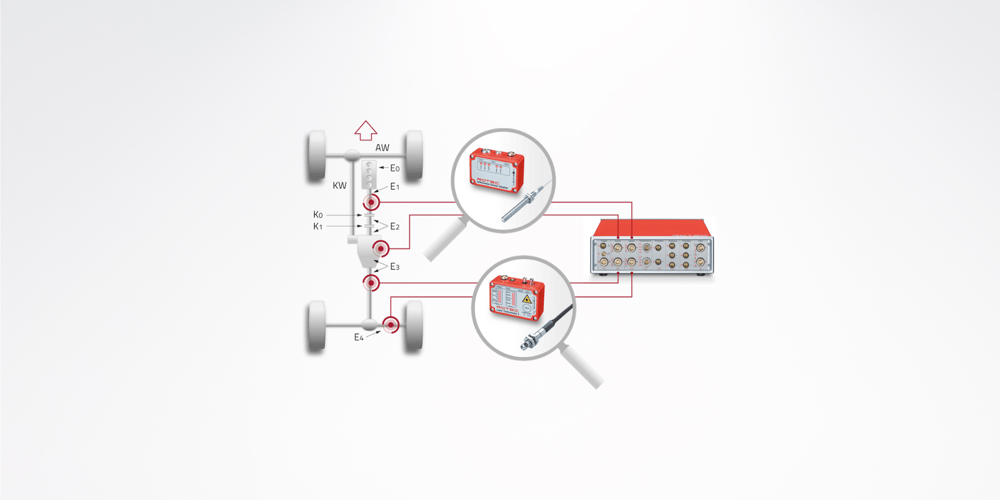
Problem: Dynamic and acoustic problems, resonances
Goal: Optimal design of the drive train, noise reduction
A holistic view is necessary to evaluate and optimize the vehicle. Dynamic effects in the entire vehicle, acoustic behavior, influences on driving behavior and interactions in the system context should be taken into account. In the dynamic design of the drive train, torsional vibration excitations, mass inertia, stiffness and damping behavior of the components play an important role. They can cause resonances and dynamic problems that affect the life of the components. Some of these parameters can be influenced by environmental conditions. Therefore, an in-depth study of the interactions of the individual components is essential. In addition, reducing noise in clutches, gearboxes and drive shafts is an important development goal.
In the diagram, a multi-channel speed measurement using magneto-resistive sensors and laser sensors provides, for example, cardan shafts (KW), drive shafts (AW), clutches (K0, K1), electric motors (E0-4) and gearboxes in combination with analog measured variables such as accelerations and Sound pressure, a comprehensive overall picture of the vibration behavior of the drive train.
The recorded measured values are evaluated in the time and spectral domain. At the same time, the acoustic behavior is analyzed.
ROTEC ENGINEERING also supports you with technical engineering knowledge on problems relating to vibration analyzes on engines, transmissions and drive trains. With our know-how, we make a valuable contribution to your product in the areas of timing train validation, valve train optimization, clutch design, transmission errors (TE), transmission and oil balance optimization, drive train measurement and optimization, current and voltage analysis as well as the application of measurement technology.
Analyzes in the time domain
-
Dynamic twist angle in the transmission components
-
Analysis of shaft torsion
-
Sudden loads during load changes
-
Analysis of the stiffness in the drive
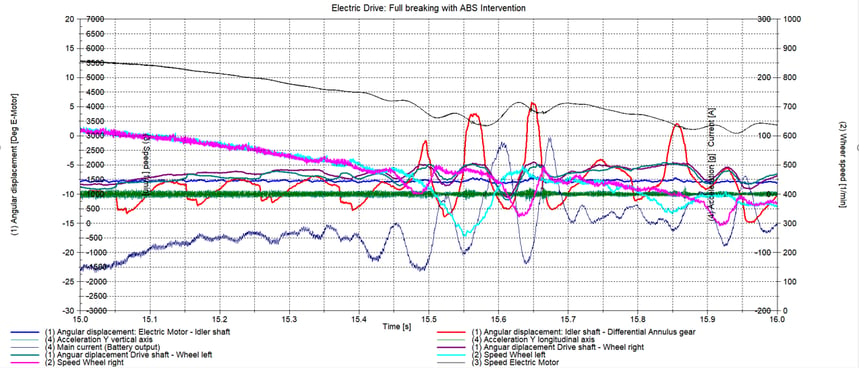
Analyzes in the spectral range
- Analysis of dynamic stimuli
- Checking vibration dampers and coupling systems
- Resonance behavior of the entire system
- Change in natural frequencies over ambient conditions
- Dynamic peak load
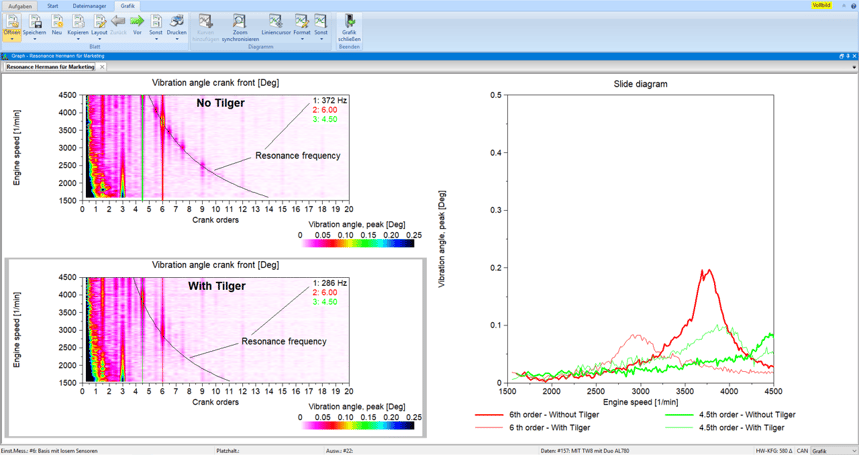
Analyzes of acoustic behavior
- Identification of noise sources
- Detecting component resonances
- Specialized software solution for transmission examinations
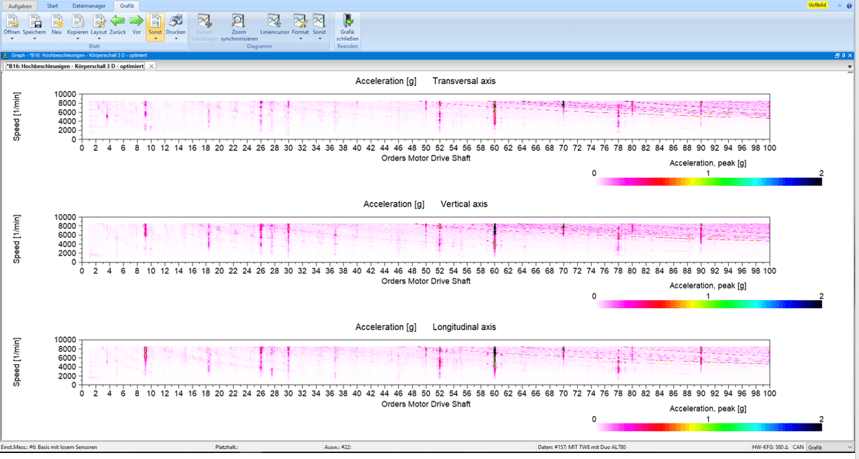
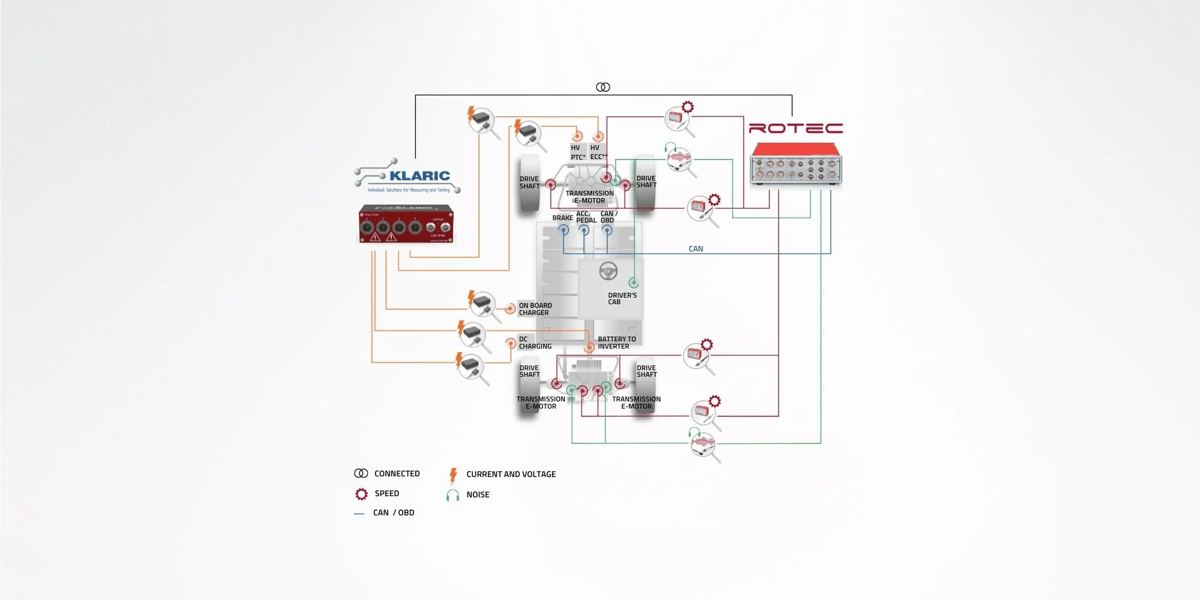
Problems: Acoustic behavior, NVH transmission (noise, vibration, harshness), dynamic loads on the electric drive train
Goal: Reliable and optimal design of the electric drive train
Electric powertrain studies pose new challenges for engineers as torsional vibrations of the electric motor and transmission lead to noise problems and potentially mechanical failures. The combination of dynamic measurement of torsional vibrations, analog sensor values, CAN/OBD data as well as current and voltage probes enables an overall analysis of the electric drive train.
In order to identify and localize the dynamic torsional vibration excitations and noise sources of an electric drive train, it is equipped with high-resolution ROTEC speed sensors and high-frequency speed measurement cards with a 12.3 GHz clock. Typical measuring points are electric motors, transmission input and output shafts. The high clock frequency makes it possible to record the dynamic angular displacement between two shafts in the µrad range and, for example, to analyze the transmission error that causes noise between two gears. In addition, microphones and accelerometers are installed in the engine compartment and in the driver's cab. For NVH examinations, ROTEC offers high-resolution analog measurement cards with IEPE channels and special NVH functions in the analysis software. KLARIC current and voltage sensors are used on the battery, DC charging, on-board charger, HV-PTC and HV-ECC. CAN signals are recorded on the CAN/OBDII interface, e.g. throttle and brake position. The recorded measured values are evaluated in the time and spectral domain.
ROTEC ENGINEERING also supports you with technical engineering knowledge on problems relating to vibration analyzes on engines, transmissions and drive trains. With our know-how, we make a valuable contribution to your product in the areas of transmission errors (TE), transmission optimization, drive train measurement and optimization, and measurement technology application.
Analyzes in the time and spectral domain
- Combination of mechanical and electrical variables (current and voltage) in the drive train
- Rotational irregularities in the drive train Transmission error (TE)
- Torques and forces
- Analysis of speeds and acoustic behavior
- Drivetrain efficiency
- Efficiency of consumers and the entire vehicle
- Control behavior e.g. of inverter, ABS, ESP
- Correlation between acoustics, rotational inequalities as well as torques and forces
- Identification of noise sources Detection of component resonances
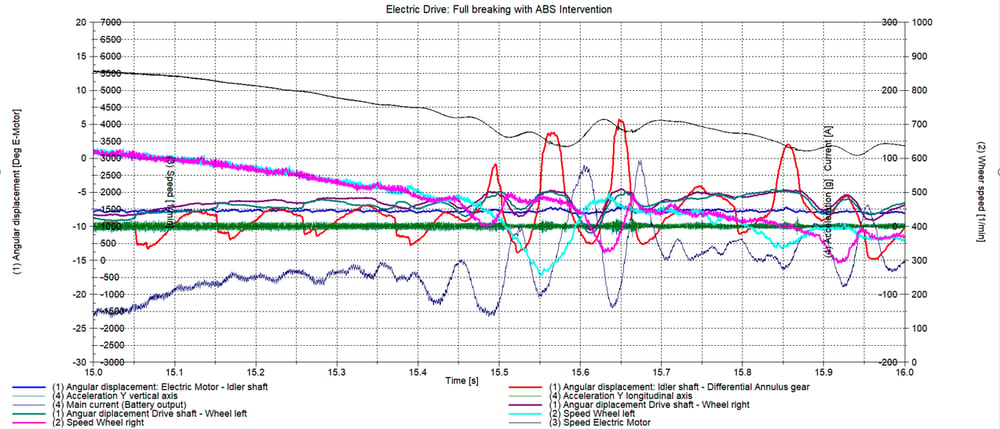
Case Study & Video
Causes of noise behavior and effects of torsional vibrations on the electric drive train
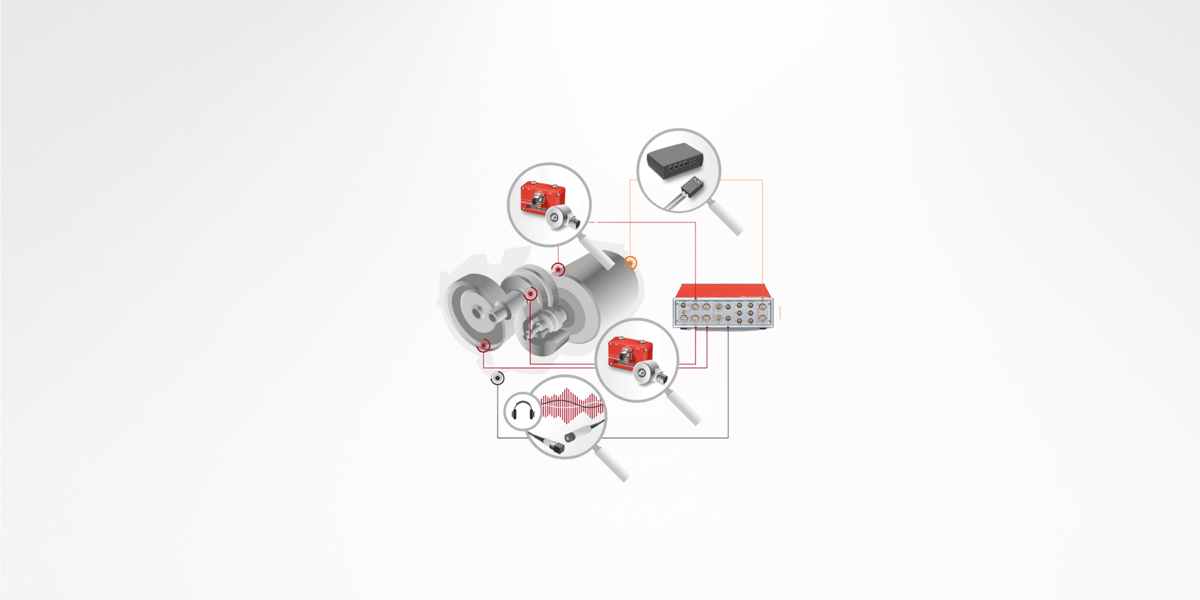
Problem: Audible and noticeable vibrations, NVH (noise, vibration, harshness)
Goal: More driving comfort
The electric axle drive is increasingly convincing when used in electric vehicles: with a lower weight, it promises more power and range.
The three drive parts: electric motor, transmission and power electronics are combined into a compact unit in the electric axle drive. Due to the limited installation space, the individual components of the entire drive unit must be optimally coordinated with one another in terms of strength, weight and sound transmission. Otherwise, audible and noticeable vibrations may occur, which influence driving comfort. The investigation of torsional vibrations in the electric axle drive is therefore fundamental for the analysis of noise excitations and the NVH (noise, vibration, harshness) behavior.
In the diagram, the speeds at the electric motor, at the transmission output and at the intermediate shafts are recorded in high resolution. The clock frequency of the ROTEC speed card is 12.3 GHz. In this way, the torsional vibration of the shafts as well as the angle of rotation between two shafts can be measured in the µrad range. The transmission error (TE) of the gears is therefore displayed with the highest level of accuracy. This parameter is important for describing the excitation of gearbox whine (GWN) and indispensable for a deeper understanding of NVH behavior. At the same time, structure-borne sound signals are recorded with an accelerometer and microphones and then evaluated together in the order and frequency ranges. To measure electrical variables such as currents and voltages, we use the high-precision HV measuring probes from the partner company KLARIC.
The recorded measured values are evaluated in the time domain. At the same time, the acoustic behavior is analyzed.
ROTEC ENGINEERING also supports you with technical engineering knowledge on problems relating to vibration analyzes on engines, transmissions and drive trains. With our know-how, we make a valuable contribution to your product in the areas of timing train validation, valve train optimization, clutch design, transmission errors (TE), transmission and oil balance optimization, drive train measurement and optimization, current and voltage analysis as well as the application of measurement technology.
Analyzes in the time domain
- Dynamic twist angle in the transmission components
- Analysis of shaft torsion
- Sudden loads during load changes
- Analysis of the stiffness in the drive
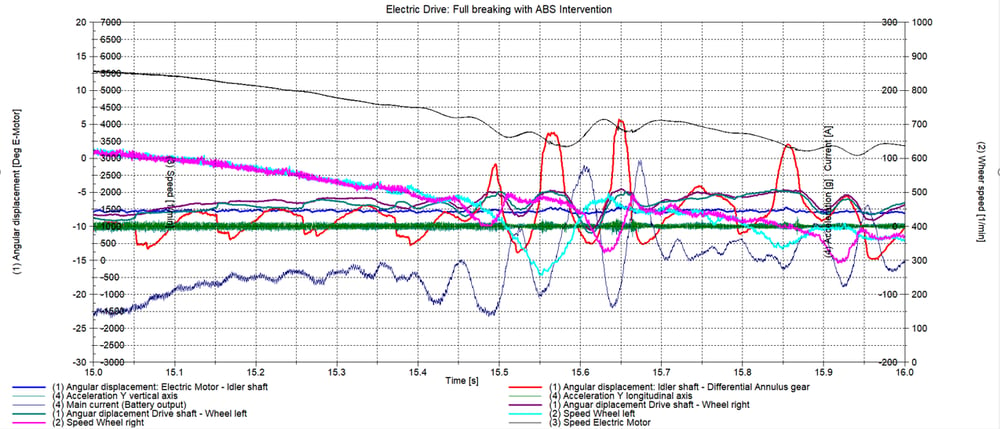
Analysis of acoustic behavior
- Identification of noise sources
- Detection of component resonances
- Specialized software solution for transmission examinations
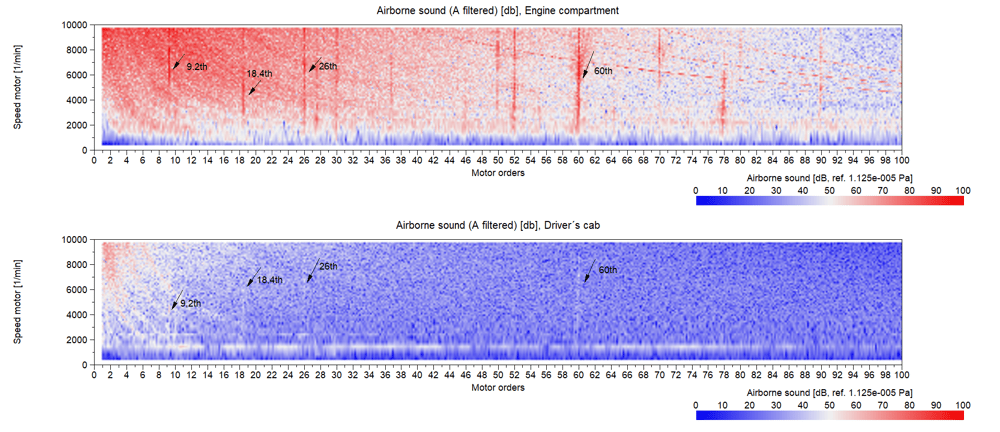
Any more questions?
What does the ROTEC solution for rotation analysis look like and what does RAS mean?
The ROTEC Rotational Analysis System (RAS) has been used for more than 30 years by users in the mechanical engineering, automotive, power generation and motorsport industries for the comprehensive analysis of rotating components.
With its unique measurement method using a 12.3 GHz counter card and a strictly angle-based approach to rotational speed detection and analysis, the RAS system offers users an unparalleled advantage.
ROTEC offers not only optical and magnetic speed sensors including signal conditioning adapters, but also the modular measuring system RASdelta as well as specialized and user-friendly software for measurement and analysis. This enables a complete solution from a single source. The ROTEC measurement technology products are perfectly matched to each other and deliver meaningful results within a very short time after the uncomplicated setup of the measurement chain.
Thanks to the angle-based approach to speed measurement, problems such as sensor vibrations can be detected after the first measurement and rectified immediately. This effectively prevents costly incorrect measurements.
Our team of experts at ROTEC ENGINEERING, consisting of long-standing users, will be happy to assist you with challenging tasks.
Are there options for customizing the measurement systems and software?
The ROTEC RASdelta front end is a versatile modular measurement system that can be individually configured with 8 or 16 measurement cards to meet your specific measurement requirements.
Our RAS software offers you a comprehensive modular system for analyzing rotating components and complex systems. It is an effective tool for machine builders and requires no programming knowledge to carry out measurements or perform evaluations.
If you have specific metrological questions, our experienced ROTEC ENGINEERING consulting team will be happy to support you.
Does ROTEC offer other services in addition to the measuring systems, e.g. individual consulting or project support?
ROTEC offers not only speed sensors, signal conditioning, measurement systems (DAQ) and measurement and evaluation software, but also engineering and consulting services.
Our services include the design of measuring points in CAD, the mechanical processing of components, the application and calibration of sensors, the execution of measurement tasks and the evaluation of measurements in accordance with our customers' requirements, including the presentation of the results. The ROTEC ENGINEERING team can also implement sub-projects as part of project support.
Is there training or technical support for commissioning and integrating the measuring systems?
In addition to our annual ROTEC Training Week, which is held in both German and English, we also offer customized training courses for users. These training courses are specially tailored to your individual application of the ROTEC measuring system and include not only the theoretical basics and a detailed presentation of the software, but also practical demo measurements in your environment. This ensures that future users are optimally prepared for your specific application.
Furthermore, we are happy to support you in the commissioning of new measuring systems to enable you to become familiar with the settings and possibilities of the RAS software as quickly as possible.
How is support ensured and are there self-help options?
In addition to our sales and support team in Munich, which serves the Central European market directly from here, ROTEC also cooperates with local partners in many global markets. These partners support local users with trained personnel for all matters relating to ROTEC measurement technology, first-level support and sales inquiries.
Our customers around the world appreciate the proximity of our sales and support teams, as this enables us to guarantee effective support even for short-term questions.
In addition to personal contact, ROTEC also offers an extensive knowledge database for self-help. Please register for our knowledge database to obtain detailed information on measuring and evaluating torsional vibrations, transmission errors and valve systems, among other things.